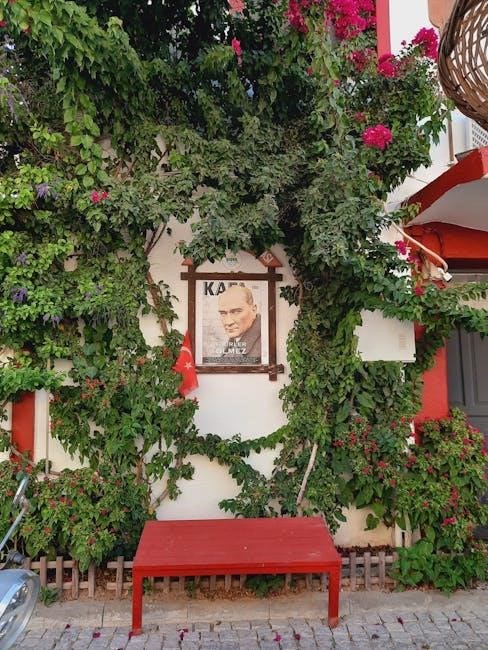Explore Robert Frost’s timeless poem, Mending Wall, a profound exploration of isolation, tradition, and human connection. Available in PDF, it remains a cornerstone of American poetry.
Overview of the Poem
Mending Wall by Robert Frost is a thought-provoking poem that explores themes of isolation, tradition, and human interaction. It recounts the annual ritual of two neighbors repairing a stone wall that separates their properties. The speaker questions the necessity of the wall, while his neighbor adheres to the adage, “Good fences make good neighbors.” The poem delves into the tension between tradition and progress, highlighting the complexities of human connection. It is widely studied and available in PDF formats for educational purposes.
Publication and Background
Mending Wall was first published in Robert Frost’s second collection of poetry, North of Boston, in 1914. This book marked a significant turning point in Frost’s career, establishing him as a major poetic voice. The poem is set in rural New England, reflecting Frost’s deep connection to the region and its traditions. It remains one of his most celebrated works, often studied for its themes of isolation and human interaction. The poem is widely available in PDF format for academic and personal study.

Historical Context
Written in 1914, Mending Wall reflects rural New England life, exploring themes of tradition and isolation, influenced by Frost’s personal experiences and societal norms of the era.
Frost’s Life and Career
Robert Frost (1874-1963) was a celebrated American poet known for his vivid depictions of rural New England life. Born in California, he later moved to New England, where he drew inspiration from the natural landscape. Frost’s career gained momentum while living in England, where he befriended notable poets like Rupert Brooke and Ezra Pound. His work, often exploring themes of isolation and tradition, earned him four Pulitzer Prizes. Mending Wall was first published in his collection North of Boston (1914), marking a pivotal moment in his literary career.

Publication in North of Boston
Mending Wall was first published in Robert Frost’s second poetry collection, North of Boston, in 1914. This collection marked a significant turning point in Frost’s career, as it introduced his unique rural New England voice to a broader audience. The poem’s inclusion helped establish Frost as a major literary figure, blending traditional forms with modern themes. Its publication in North of Boston remains a cornerstone of American poetry, widely studied and admired today.
Influence of Contemporary Poets
During his time in England, Frost interacted with notable poets like W.B. Yeats, T.S. Eliot, and Ezra Pound, whose modernist influences shaped his work. These interactions likely inspired Frost to blend traditional rural themes with contemporary poetic styles, as seen in Mending Wall. The poem’s structure and themes reflect Frost’s unique voice, yet its depth and complexity reveal the impact of his literary circle, bridging the gap between classic and modern poetry.

Poetic Structure and Form
Mending Wall showcases Frost’s mastery of form, featuring a continuous, forty-five-line narrative without stanzas, maintaining iambic rhythm, and blending rural simplicity with philosophical depth, available in PDF format.
Structure and Style
Robert Frost’s Mending Wall is structured as a continuous, forty-five-line narrative, eschewing traditional stanzas. The poem employs a conversational tone, blending rural simplicity with philosophical depth. Frost’s use of iambic pentameter creates a rhythmic flow, mirroring the natural cadence of speech. This style allows the speaker to reflect on themes like tradition, isolation, and human connection, while the lack of formal stanzas emphasizes the fluid, unstructured nature of the dialogue between the neighbors. The poem’s accessible yet profound style has made it a cornerstone of American literature, readily available in PDF formats for study and analysis.
Use of Iambic Pentameter
Robert Frost’s Mending Wall is notable for its use of iambic pentameter, which creates a rhythmic, conversational flow. The meter underscores the poem’s natural, spontaneous tone, reflecting the speaker’s contemplative dialogue. Frost’s adherence to this structure enhances the poem’s musicality, while subtle variations in rhythm mirror the speaker’s shifting emotions and the tension between tradition and doubt. This masterful use of iambic pentameter contributes to the poem’s enduring appeal and accessibility, as seen in its widely available PDF formats for scholarly and personal reading.
Stanza and Line Analysis
Frost’s Mending Wall consists of 45 lines without formal stanzas, creating a fluid, conversational tone. The poem’s structure mirrors the natural dialogue between the speaker and his neighbor. Lines like “Something there is that doesn’t love a wall” introduce themes of division and unity. The lack of traditional stanza breaks emphasizes the continuous, unstructured nature of their interaction. This format, along with the poem’s availability in PDF, allows readers to analyze its rhythmic flow and deeper meanings in a straightforward manner.

Themes Explored in the Poem
The poem delves into themes of isolation, tradition, and human connection, using the wall as a metaphor for barriers between people and the futility of division in fostering understanding.
Isolation and Human Connection

The poem explores the tension between isolation and human connection through the wall, symbolizing a physical and emotional barrier. The speaker questions its necessity, reflecting on the futility of division. While the neighbor adheres to tradition, the speaker seeks understanding, highlighting the struggle between solitude and unity. This dynamic underscores the human need for connection despite the walls we build, both literally and metaphorically, to separate ourselves from others.
Tradition and Ritual
The poem delves into the theme of tradition through the annual ritual of mending the wall. The neighbor’s unwavering commitment to this practice, despite its seeming futility, highlights the power of tradition. The repeated act of repairing the wall symbolizes a deeply ingrained habit, passed down through generations. Frost explores how traditions, even when questioned, are often maintained to preserve order and reinforce societal norms. The ritual becomes a metaphor for the human tendency to cling to familiar customs, even when their purpose fades.

Communication and Misunderstanding
The poem highlights the tension between the speaker and his neighbor, showcasing a lack of meaningful communication. Their dialogue reveals differing perspectives: the speaker questions the wall’s necessity, while the neighbor adheres to tradition without reflection. The repetition of “Good fences make good neighbors” underscores the neighbor’s refusal to engage deeply, symbolizing a broader human tendency to cling to phrases rather than understanding. This exchange illustrates how misunderstandings arise from unchallenged assumptions and the absence of genuine dialogue;
Human Nature and Conflict
The poem delves into inherent human tendencies, where conflict often stems from differing values and perspectives. The speaker’s introspection contrasts with his neighbor’s rigid adherence to tradition, highlighting the clash between progress and stagnation. The act of mending the wall symbolizes the cyclical nature of conflict, as neither party truly resolves their differences. Frost portrays human nature as both cooperative and divisive, revealing how shared tasks can mask deeper, unaddressed tensions that persist through generations.
Symbols and Imagery
Frost uses the wall, nature, and seasonal changes as symbols. The wall represents division and tradition, while the natural landscape signifies unity and change, exploring deeper human themes.
The Wall as a Symbol
The wall in Frost’s poem symbolizes division and tradition, highlighting human efforts to separate and define boundaries. It represents both physical and metaphorical barriers, questioning their necessity. The speaker’s neighbor adheres to the adage “Good fences make good neighbors,” emphasizing tradition’s role. Yet, the wall’s deterioration and the natural world’s indifference suggest futility in human constructs. This duality explores themes of isolation, unity, and the tension between progress and tradition, making the wall a powerful and enduring symbol in American literature.
Nature and the Landscape
Nature plays a central role in Mending Wall, with the frozen ground and shifting boulders symbolizing forces beyond human control. Frost’s depiction of the natural world contrasts with the artificial barrier, highlighting its futility. The landscape reflects the cyclical passage of time, as the wall’s annual repair becomes a ritual. Through vivid imagery, Frost illustrates how nature subtly undermines human efforts to impose order, emphasizing the tension between the natural and constructed worlds.
The Neighbors and Their Relationship
The speaker and his neighbor in Mending Wall embody contrasting perspectives on tradition and isolation. The speaker questions the wall’s necessity, while his neighbor adheres to the adage, “Good fences make good neighbors.” Their annual ritual of repairing the wall highlights their complex dynamic—cooperation laced with underlying tension. Frost portrays their interaction as a microcosm of human relationships, where mutual effort coexists with misunderstandings, reflecting broader themes of unity and division in society.
The Neighborly Relationship
The speaker and his neighbor in Mending Wall share a complex bond, cooperating annually to repair the wall while holding contrasting views on its necessity and symbolism.
The Speaker’s Perspective
The speaker in Mending Wall voices skepticism about the wall’s purpose, questioning its necessity since it separates only trees, not livestock. He reflects on the futility of rebuilding it annually, suggesting a deeper philosophical inquiry into tradition and human connection. His neighbor’s rigid adherence to the saying “Good fences make good neighbors” contrasts with the speaker’s more introspective and doubtful outlook, highlighting themes of isolation and the complexities of neighborly relationships.
The Neighbor’s Adherence to Tradition
The neighbor’s unwavering commitment to mending the wall reflects his deep-rooted belief in tradition and the proverb “Good fences make good neighbors.” Despite the speaker’s skepticism, he diligently repairs the barrier, emphasizing the importance of maintaining boundaries. His actions symbolize a steadfast loyalty to established customs, even when their practicality is questioned, underscoring the tension between progress and tradition in the poem.
Dynamics of Cooperation and Conflict
The poem illustrates a complex interplay between cooperation and conflict as the two neighbors annually repair the wall. While they work together, their differing views on the wall’s necessity create subtle tension. The speaker questions the purpose, while the neighbor adheres to tradition, revealing underlying philosophical differences. This dynamic highlights how shared tasks can both unite and divide individuals, reflecting broader human struggles with collaboration and understanding.
Message and Meaning
The poem explores themes of barriers, unity, and isolation, questioning the purpose of divisions while highlighting the importance of human connection and understanding.
Barriers and Divisions
The poem delves into the symbolism of the wall as a physical and emotional barrier, reflecting the tension between separation and unity. Frost questions the necessity of such divisions, suggesting they often stem from tradition rather than practical need. The wall represents a literal and metaphorical divide, highlighting themes of isolation and misunderstanding. Through the speaker’s perspective, the poem critiques the futility of constructing barriers, emphasizing how they can foster disconnection rather than connection.
The Futility of Walls
Frost examines the futility of walls as symbols of division and separation. The poem illustrates how natural forces and human actions continually undermine the wall’s purpose, highlighting its inherent fragility. Despite annual repairs, gaps persist, suggesting that barriers are inherently impermanent. The speaker’s skepticism toward the wall’s necessity underscores the idea that physical and metaphorical walls often fail to achieve their intended purpose, instead fostering isolation and misunderstanding. This theme resonates universally, questioning the effectiveness of division in human societies.
Unity and Togetherness
The poem subtly explores the theme of unity through the annual ritual of mending the wall. Despite their differences, the speaker and his neighbor cooperate to repair the barrier, symbolizing a fragile harmony. The act of working together highlights the possibility of connection, even amid underlying tensions. Frost suggests that shared tasks can foster unity, transcending the divisions walls represent. However, the speaker’s questioning of the wall’s necessity hints at the limitations of such unity in resolving deeper conflicts.

Cultural and Historical Context
Mending Wall reflects rural New England life, exploring themes of tradition and isolation. Published in 1914, it captures the essence of a fading agricultural way of life, emphasizing the importance of boundaries in a changing world.
Rural New England Life
Set against the backdrop of rural New England, Mending Wall portrays a traditional farming community. The annual ritual of repairing the wall symbolizes the enduring customs and isolation of the region. Frost vividly captures the landscape and the quiet, laborious life of its people, emphasizing themes of solitude and the passage of time. The poem offers a glimpse into a disappearing way of life, reflecting the simplicity and resilience of New England’s agrarian culture.
Biblical and Historical Allusions
Robert Frost’s Mending Wall contains subtle biblical and historical allusions, adding depth to its themes. The title itself evokes imagery of divine repair, reflecting themes of salvation and redemption. The act of mending the wall mirrors ancient rituals of restoration, while the poem’s exploration of boundaries and division hints at historical conflicts and the human condition. These allusions enrich the poem’s universal appeal, inviting readers to connect its rural setting to broader cultural and theological narratives.
Reception and Impact
Mending Wall has been widely acclaimed for its exploration of human relationships and nature, becoming a cornerstone of American poetry and a popular study resource in PDF format.
Initial Reviews and Reception
Upon its publication in 1914, Mending Wall received mixed reviews. Some critics praised its rural New England imagery and symbolic depth, while others found it too simplistic. The poem’s exploration of themes like isolation and tradition resonated deeply, establishing Frost as a major literary figure. Over time, it has become a celebrated work, widely studied and admired for its nuanced commentary on human nature and society.
Modern Interpretations
Contemporary readers often view Mending Wall as a metaphor for barriers in relationships and society. The poem’s themes of isolation and communication resonate in today’s globalized world, where divisions persist. Frost’s exploration of tradition versus progress is particularly relevant, inviting readers to reflect on the necessity of boundaries. Modern interpretations emphasize the poem’s universality, making it a timeless reflection on human interaction and the futility of division.
Legacy in American Poetry
Mending Wall stands as a cornerstone of American poetry, showcasing Frost’s mastery of rural New England life. Its exploration of isolation, tradition, and human connection continues to resonate. The poem’s innovative use of blank verse and its nuanced portrayal of neighborly dynamics have influenced generations of poets. As part of Frost’s second collection, North of Boston, it solidified his reputation as a major literary figure. Today, it remains a timeless classic, widely studied and admired for its depth and universal themes.

Analysis of Specific Lines
Frost’s iconic line, “Good fences make good neighbors,” explores themes of isolation and tradition, while “Something there is that doesn’t love a wall” questions human divides.
“Good Fences Make Good Neighbors”
The phrase “Good fences make good neighbors” is central to Mending Wall, highlighting the tension between tradition and unity. Frost uses it to critique isolationism, suggesting that walls create barriers rather than foster understanding. The speaker questions this adage, reflecting on the futility of physical and emotional divisions. This line has become a cultural reference, sparking debates on nationalism and community, emphasizing the poem’s enduring relevance in exploring human connections and conflicts.
Implications and Interpretations
Mending Wall explores themes of isolation, tradition, and communication, with the wall symbolizing division and human tendency to separate. Frost questions the necessity of such barriers, suggesting they stem from misunderstandings rather than genuine need. The poem’s implications extend beyond rural life, reflecting on broader societal divisions and the futility of physical or emotional walls. Its interpretations highlight the universal human struggle to balance independence with connection, making it a timeless reflection on unity and separation.
Robert Frost’s Mending Wall remains a timeless reflection on human connection and division, urging readers to question the barriers we build and the unity we seek.
Mending Wall by Robert Frost explores themes of isolation, tradition, and communication through the annual ritual of repairing a stone wall. The speaker questions the wall’s necessity, while his neighbor adheres to tradition, highlighting the tension between progress and convention. The poem’s symbolic wall represents barriers in human relationships, urging reflection on unity and division. Available in PDF, Frost’s work remains a timeless commentary on human nature and societal norms, resonating with readers globally.
Final Thoughts on the Poem’s Significance
Robert Frost’s Mending Wall offers a timeless message about human connections and the barriers we construct. The poem’s exploration of tradition, isolation, and communication resonates universally, inviting readers to reflect on their own relationships and societal divisions. Its enduring relevance lies in its ability to provoke thought on unity and separation, making it a cornerstone of American literature. Available in PDF, the poem remains accessible for study and appreciation, ensuring its legacy endures for future generations.
PDF and Online Resources

Download Mending Wall as a free PDF or explore study guides and educational resources online for deeper analysis of Frost’s timeless poem.
Availability of the Poem in PDF Format
Robert Frost’s Mending Wall is widely available in PDF format, accessible through various educational platforms and literary websites. This convenient format allows readers to download and study the poem seamlessly, enhancing accessibility for both academic and personal use. The PDF versions often include annotations and analyses, providing deeper insights into Frost’s themes and poetic techniques. This accessibility ensures that the poem remains a vital resource for scholars and poetry enthusiasts alike.
Online Analysis and Study Guides
Various online platforms offer detailed analyses and study guides for Mending Wall, providing insights into its themes, structure, and symbolism. These resources include line-by-line interpretations, thematic discussions, and historical context, aiding students and enthusiasts in understanding Frost’s work. Many study guides are available in downloadable formats, complementing the PDF versions of the poem. These tools enhance comprehension and appreciation of Frost’s exploration of isolation, tradition, and human connection.
Educational Resources and Downloads
Educational resources for Mending Wall include downloadable PDFs, lesson plans, and activities tailored for classroom use. These resources provide teachers with structured approaches to explore the poem’s themes, imagery, and poetic devices. Students benefit from interactive exercises and essay prompts, fostering deeper engagement with Frost’s work. Additionally, downloadable study guides and analysis tools offer comprehensive support for academic exploration and critical thinking.